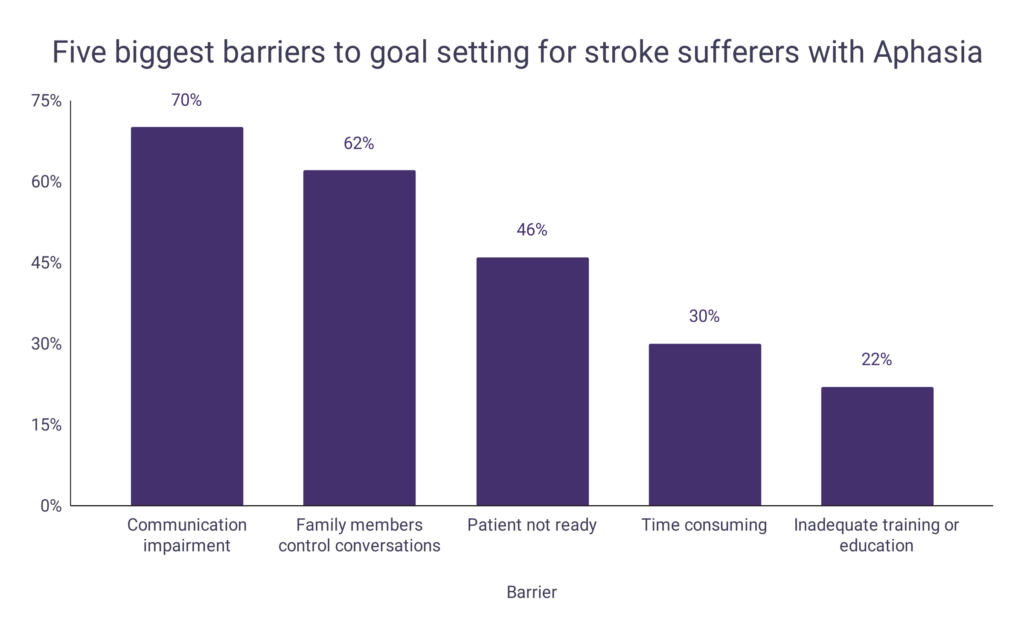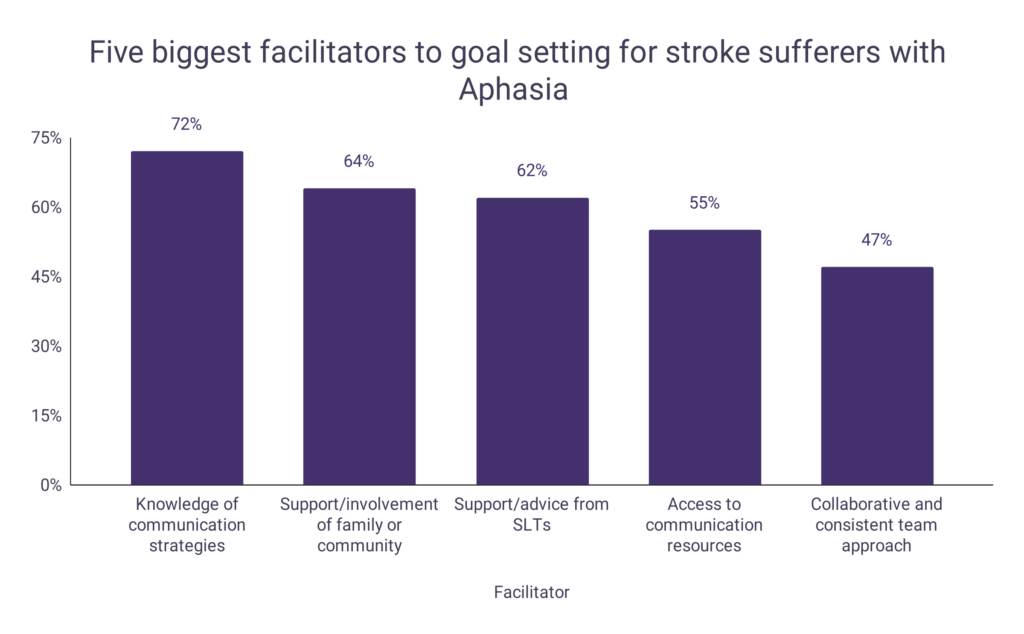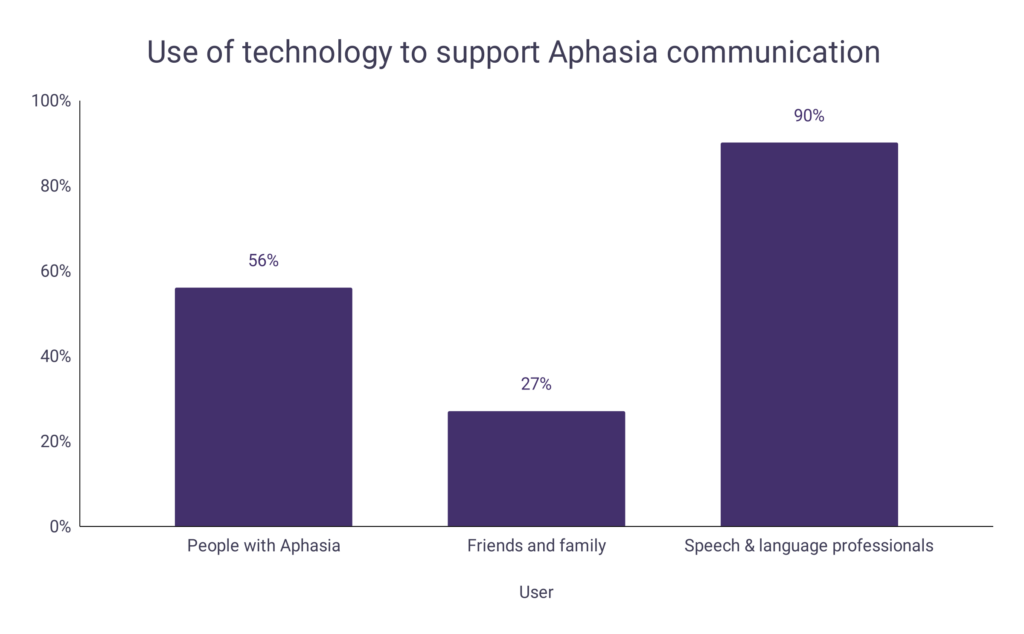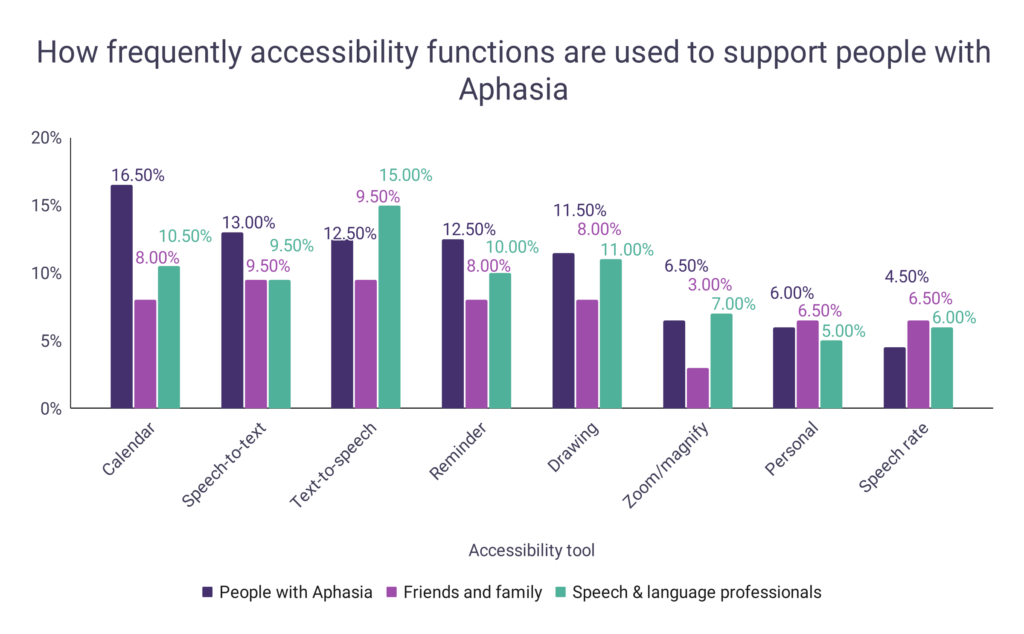Although millions of people suffer from Aphasia all over the world, it is still relatively unknown when compared to other disorders. This research article looks at how it is caused, what its symptoms are and the different techniques/tools used to improve the condition of its sufferers.
Disclaimer: This article is not to be used for medical advice and is only intended to provide information.
- In the US, Aphasia affects around 2 million people.
- 1 in 272 Americans are affected with Aphasia and there are 180,000 new cases in the US annually.
- This makes Aphasia more common than Parkinson’s disease, cerebral palsy or muscular dystrophy.
- Around a third of Aphasia cases are linked to cerebrovascular accidents.
- Due to damage of the language-processing regions in the brain, 25% to 40% of stroke survivors develop Aphasia.
- In a 2022 survey, 67.8% people reported hearing the term “Aphasia”, increasing significantly since 2020 (when the figure was just 13.8%).
- Furthermore, 40% of people have heard of the term whilst also knowing that it is a disorder related to language.
- Around 1 in 5 respondents mentioned Bruce Willis’ diagnosis of Aphasia as their last recalled reading or hearing of the disorder.
- 24.1% of respondents either believed or were not sure if Aphasia was linked to intellectual difficulties.
- As Aphasia isn’t linked to intelligence, it is important to emphasize this and also continue to grow its overall awareness.
If somebody you know suffers from Aphasia, you may be able to help them recover lost vocabulary by using WordLists. With these, you can search for words based on their length and the letters they contain, before turning them into word making exercises based on their perceived difficulty.
Common types of Aphasia
Aphasia can affect a person’s communication skills to varying degrees. Whilst the most minor cases of Aphasia will show a low impact on the individual, severe cases can be extremely debilitating.
- There are 8 main categorizations of Aphasia based on the individual’s capacities.
- Those with the disorder can be assessed based on their speech fluency, speaking comprehension and their ability to repeat words or phrases.
- Due to this, Global Aphasia is the most severe form of the disorder, as sufferers are unable to do all three.
- On the other hand, Anomic Aphasia is the least severe as sufferers can speak fluently, comprehend spoken words and also repeat language.
| Aphasia type | Is speech fluent? | Can comprehend? | Can repeat? |
| Global Aphasia | No | No | No |
| Mixed Transcortical Aphasia | No | No | Yes |
| Broca’s Aphasia | No | Yes | No |
| Transcortical Motor Aphasia | No | Yes | Yes |
| Wernicke’s Aphasia | Yes | No | No |
| Transcortical Sensory Aphasia | Yes | No | Yes |
| Conduction Aphasia | Yes | Yes | No |
| Anomic Aphasia | Yes | Yes | Yes |
How is Aphasia caused?
- Damage to the parts of the brain responsible for producing and understanding language can cause Aphasia.
- The most common causes for the disorder are as follows:
- Strokes
- Severe head injuries
- Brain tumors
- Progressive neurological conditions
- Due to these causes, Aphasia is most commonly suffered by people over the age of 65.
Goal setting and Aphasia
By implementing goal setting with Aphasia sufferers, its symptoms can be reduced and the overall condition of the patient can be improved over time. For the most severe sufferers, work on regaining shorter words of 2, 3 and 4 letters before engagement of mid-length words. Words of 11 and 12 letters should only be attempted with those with significantly improved symptoms.
Barriers to goal setting
- A study into goal setting for stroke sufferers with Aphasia found that communication impairment is reported as the biggest barrier to goal setting by stroke rehabilitation staff.
- This was followed by disruptive family members (2nd) and the patient not being ready (3rd).
| Barrier | Percentage |
| Communication impairment | 70% |
| Family members control conversations | 62% |
| Patient not ready | 46% |
| Time consuming | 30% |
| Inadequate training or education | 22% |
| Staff lacking confidence | 19% |
| Limited opportunities | 19% |
| Inadequate access to resources | 19% |
| Patient not willing | 16% |
| Limited or no collaboration across wider team | 16% |
| Limited or no input from speech & language therapists (SLTs) | 10% |
| No barriers | 4% |
A graph is given below to show the five biggest barriers to goal setting for stroke sufferers with Aphasia:

Facilitators to goal setting
- On the other hand, having knowledge of communication strategies is reported as the greatest facilitator to goal setting.
- After this came support/involvement of the patient’s family/community (2nd) and support/involvement from speech and language therapists (3rd).
| Facilitator | Percentage |
| Knowledge of communication strategies | 72% |
| Support/involvement of family or community | 64% |
| Support/advice from speech and language therapists (SLTs) | 62% |
| Access to communication resources | 55% |
| Collaborative and consistent team approach | 47% |
| More time allocated to sessions | 42% |
| Mentoring from more experienced staff | 30% |
| Aphasia lead individual | 9% |
| No facilitator | 3% |
| Other | 3% |
A graph is given below to show the five biggest facilitators to goal setting for stroke sufferers with Aphasia:

Technology and Aphasia
Using technology to aid those with Aphasia can alleviate symptoms, making it easier for sufferers to communicate with the others around them.
General usage
- A 2018 study found that over 1 in 2 (56%) people who suffer from Aphasia report using technology to support communication.
- A greater percentage of speech and language professionals report using technology for the same reason (90%).
- Unfortunately, less than a third (27%) of friends and family of Aphasia sufferers report using technology in this way.
| User | Use tech to support communication? |
| People with Aphasia | 56% |
| Friends & family | 27% |
| Speech & language professionals | 90% |
A graph is given below to show how frequently technology is used to support Aphasia communication:

Accessibility functions on devices
- Calendars were the most popular accessibility function used by Aphasia sufferers (16.50%).
- Speech-to-text (13.00%), text-to-speech and reminders (each 12.50%) were the next most popular.
- For the friends and family of Aphasia sufferers, speech-to-text and text-to-speech were used most frequently (9.50% each).
- 15.00% of speech & language professionals use text-to speech and 11.00% use drawing accessibility functions to help those with Aphasia.
| Accessibility function | People with Aphasia | Friends and family | Speech & language professionals |
| Calendar | 16.50% | 8.00% | 10.50% |
| Speech-to-text | 13.00% | 9.50% | 9.50% |
| Text-to-speech | 12.50% | 9.50% | 15.00% |
| Reminder | 12.50% | 8.00% | 10.00% |
| Drawing | 11.50% | 8.00% | 11.00% |
| Zoom/magnify | 6.50% | 3.00% | 7.00% |
| Personal assistant | 6.00% | 6.50% | 5.00% |
| Speech rate | 4.50% | 6.50% | 6.00% |
A graph is given below to show how frequently accessibility functions are used to support people with Aphasia:

How to communicate to somebody with Aphasia
Before communicating to somebody with Aphasia, is it important to make sure you have their attention. This also includes eliminating or reducing background noise wherever possible. Importantly, Aphasia sufferers should be encouraged to be independent, included in normal activities and not shielded from conversations.
Speaking
- Try to keep the level of your voice at a normal level, unless asked to change it.
- Communication should remain age-relevant, but using simplified sentence structures and reduced rates of speech.
- Try to supplement your words with gestures, drawings, writing and facial expressions.
- It can also be beneficial to emphasize key words you use.
- Finally, make sure not to “talk down” to the person with Aphasia.
Listening
- When listening, allow time for the person to speak.
- Do not try to finish sentences or offer words in assistance voluntarily.
- However, if the person with Aphasia asks for assistance, you can offer them the word or phrase they are looking for.
- Do not insist that each word they speak needs to be pronounced perfectly.
- After they have spoken, praise their attempts to speak and do not give any importance to errors.
Aphasia FAQ
Does Aphasia affect intelligence?
- Although a person with Aphasia can have difficulties when retrieving words and names, their intelligence essentially remains intact.
- Their ideas and thoughts are not disrupted, however communication is affected.
- Unfortunately, as the difficulty lies with communicating, Aphasia is often mistaken for other conditions.
Is it possible to recover from Aphasia?
- If the person suffering from Aphasia shows symptoms that last longer than two or three months, the likelihood of a complete recovery is low.
- Even though this is the case, some people will continue to improve their condition over a large number of years.
- Overall, improvement can be a very slow process.
- It is extremely important to help the individual and their family understand the nature of the condition and provide them with learning strategies to aid communication.
Can people with Aphasia work?
- Many job positions require a person to demonstrate speech and language skills.
- Due to this, Aphasia can make many roles difficult for those that suffer bad symptoms from the condition.
- The severity of the Aphasia plays a huge factor in whether or not a person will be able to work.
At what age do people suffer from Aphasia?
- It is possible for people of all ages to suffer from Aphasia.
- However, the majority of people that suffer from the disorder are middle-aged.
- Aphasia is more likely to affect individuals of this age group as it is frequently caused by strokes and progressive neurological conditions.

